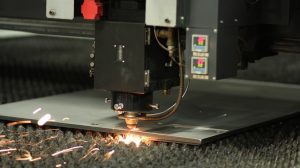Home /
Stainless Steel Plate 310 310S 310H ASTM A240
310, 310S and 310H Stainless Steel Plate Overview

310, 310S and 310H stainless steel plate is an austenitic stainless steel used in high temperature applications. It is used in temperatures up to 2,100℉ in continuous service. This grade contains 25% chromium and 20% nickel, making it highly resistant to oxidation and corrosion. 310S stainless steel is the lower carbon version of 310 plate which is less prone to embrittlement and sensitization in service. 310H stainless steel plate is the high carbon version. They are widely used in moderately carburizing atmospheres, as encountered in petrochemical environments. These grades are not recommended for frequent liquid quenching as it suffers from thermal shock. It is often used in cryogenic applications, due to its toughness and low magnetic permeability.
These grades are available for purchase at Penn Stainless products in coil and plate mill plate. These grades are available in thicknesses ranging from 0.188” to 1.5”. It is available in coil plate lengths of 96 “, 120”, 144” are typically stocked but custom lengths are also available per customer request. These grades are available in plate mill plate in a variety of mill sizes. Contact Penn Stainless Products directly for more information or custom sizes.
Chemical Composition of 310, 310S and 310H Stainless Steel Plate
310 plate contains no more than 0.25% carbon while 310S contains at most 0.08% carbon. 310H stainless steel is comprised of between 0.04% and 0.1% carbon. 310, 310S and 310H stainless steel plate all contain 2.0% manganese, 0.045% phosphorous and 0.30% sulfur. 310 and 310S plate both contain 1.50% silicon while 310H stainless steel contains only 0.75% silicon. 310, 310S and 310H all contain between 24.0% and 26.0% chromium and between 19.0% and 22.0% nickel.
Mechanical Properties
These grades of stainless steel plate have some very important and unique mechanical properties due to their composition. To begin, these grades all have a minimum tensile strength of 75 ksi and at 0.2%. 310, 310S and 310H all have a minimum yield strength of 30 ksi and an elongation of 40%. On the Brinell hardness scale they all have a hardness of 217, and on the Rockwell B scale, they have a hardness of 95.
Physical Properties
These grades of stainless steel plate have a density of 0.285 lb/in^3 and a specific heat of 0.12 BTU/lb between 32℉ and 212℉. The electrical resistivity of 310, 310S and 310H is 30.7 Microhm-in at 68℉. These grades of plate also hav a module of elasticity of 28.5 x 10^6 psi. The melting range of these grades is between 2470℉ and 2555℉. These grades of stainless steel also have a thermal conductivity of 8.0 BTU/hr/ft^2/ft/℉.
Specifications
| 310 | 310S | 310H |
|---|---|---|
| UNS S31000 | UNS S31008 | UNS S31009 |
| ASTM A240 | ASTM A240 | ASTM A240 |
| ASTM A480 | ASTM A480 | ASTM A480 |
| ASME SA240 | ASME SA240 | ASME SA240 |
| AMS 5521 | AMS 5521 | AMS 5521 |
Applications and Uses
Applications for these grades of stainless steel plate includes the production of cryogenic components as well as use in furnaces, specifically in the construction of burner, recuperations, doors, fans, and piping. Because these grades of stainless steel can withstand very hot temperatures, it is also commonly used in the food processing industry along with in the chemical and pharmaceutical industries. They are also used on fluid bed furnaces, in coal combustor, grids, piping and wind boxes. Ore and steel processing facilities also utilize the unique properties of this stainless steel plate in smelter and steel melting as well as continuous casting equipment. These grades are also commonly used in the petroleum refining industry, particularly in catalytic recovery systems, flares, recuperates and tube hangers. This grade is used in power generation applications; it is used in coal gasifier internals, pulverized coal burners ad tube hangers. Sintering and cement plants also utilize the properties of this stainless steel plate in burners and burner shields, feeding, discharging systems and wind boxes. Another industry in which these grades of stainless steel is popularly used in the thermal processing industry. It can be found in annealing covers and boxes, burner grids, doors, fans, muffles, retorts and walking beams. These grades of stainless steel plate can withstand very high temperatures, thus making it useful to a wide range of industries.
Processing and Fabrication Options
- Plasma cutting
- Plate saw cutting
- Shearing
- Laser cutting
- Waterjet cutting
- Forming
- Welding
- Machining
- Plate leveling